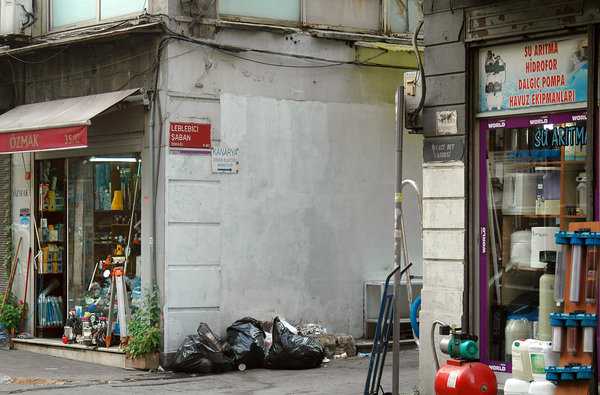By ANNA LOUIE SUSSMAN
On a Sunday afternoon earlier this summer, hundreds of Turkish men disappeared down a short alleyway just a five-minute walk from the Istanbul Modern art museum. Some flicked prayer beads around their fingers. The younger ones arrived in small groups, flashing nervous grins and smoothing their hair down with spit. They strode by a pile of garbage bags holding wadded-up tissues and cigarette butts before reaching a metal gate that separated the alley from their destination: Kadem Street, a narrow cul-de-sac and one of the country’s few remaining red-light districts.

The unsavory, garbage-strewn pathway to the city’s sex district.
A policeman scanned the men’s identification cards and ushered them through a metal detector and into the fray, where voluptuous women in bras and underwear occupied the doorways of the half-dozen houses that lined the street. Minors were refused entry. Minors who could afford a 20-lira bribe were not.
Since the 1870s, prostitution has thrived in Istanbul’s Beyoglu district, which houses Kadem and its sister street, Zurafa. For five decades, an Armenian businesswoman, Matild Manukyan, ran an empire of Beyoglu brothels that netted her an estimated $4 million annually until her death in 2001. Sunday, the last day of rest before the workweek, always brought her particularly brisk business.
Now, the alleyway leading to Kadem is lined with plumbing and appliance shops, all of which are closed on Sunday. For most of the day, the only commerce on the street consisted of a man hawking peeled cucumbers from a wooden cart at one end and a shoe shiner with bloodshot eyes and a raspy voice at the other. Midafternoon, a man trudged by with another cart, this one bearing bananas.
“Cucumbers and bananas, for energy,” explained Yenten, an unemployed construction worker. He emerged from prison two days earlier, after a three-month stint for failing to pay alimony to his ex-wife. Saturday he visited relatives, and Sunday found him sitting on the sidewalk outside Kadem, pulling on cigarettes and contemplating a little diversion.
“I’m a single man,” he said. “I need this.”
A no-frills encounter costs 35 Turkish lira, around $20. Twenty lira goes to the house, the rest to the woman. A little tenderness — kissing, caressing, honeyed words — costs 15 to 20 lira extra, which strikes Yenten as unjust.
“That place is a money trap,” he said. “If you don’t give the extra 20 lira tip, they act very rude. They just have sex and throw you out.”
Sitting next to him on the curb were two cousins, recent high-school graduates, who live on the fringes of Istanbul. The blond one was 18, short and stout, with a pimply face. “If we have money, even just a little, we come here,” he said. “These women are healthy, the government checks them and we trust them.” Other options for paid sex — “telegirls,” who are reachable via cellphone or Web sites; Eastern European women, or “Natashas,” who work out of unlicensed houses; and pavyons, hostess bars, which require an evening of drinking — hold less appeal.
His handsome, green-eyed cousin visits Kadem Street regularly, although he has a serious girlfriend whom he meets late at night in a park near his house. They kiss, but sex before marriage is out of the question. “You can’t just sleep with the girl you love,” he says. Nor can you tell her you visit brothels. “She would break up with me immediately.”
With Manukyan’s death, the city lost not only a substantial source of revenue (she reportedly paid $1.2 million in taxes in 1992), but also a good half-dozen of its best-known brothels. Her son, an engineer, closed her properties. None have reopened, a likely consequence of the ruling Islamist party’s disdain for this particular line of work.
Jafar, a mustachioed man who identified himself as a brothel guard, said the government has essentially stopped granting sex licenses. Numbers are notoriously difficult to come by, but Jafar estimates that as many as 7,000 women in Istanbul have pending applications, while only around 130, according to the research of Sevval Kilic, an activist for sex workers’ rights, are officially registered. She estimates that at least 100,000 women work in Turkey’s sex industry illegally.
Yasemin, a sex worker with full lips and blue eyes, arrived at Kadem Street eight years ago, after nearly three decades in brothels in other parts of Turkey. At 45, she doesn’t do the half-clothed-and-beckoning routine. She waits inside, listening to music on her headphones. She sees 5 to 15 clients in a day, mostly regulars, netting up to $6,000 a month. Her colleagues, she said, will see as many as 50 men in a 12-hour workday.
“Nowadays these women have all lost their morals,” she said. “There’s no more service, no more caring for the customers.”
Once upon a time, she said, “these used to be houses of love.”
Anna Louie Sussman reported from Istanbul with the support of the Pulitzer Center on Crisis Reporting.
via Dimming the Red Lights in Turkey – NYTimes.com.
